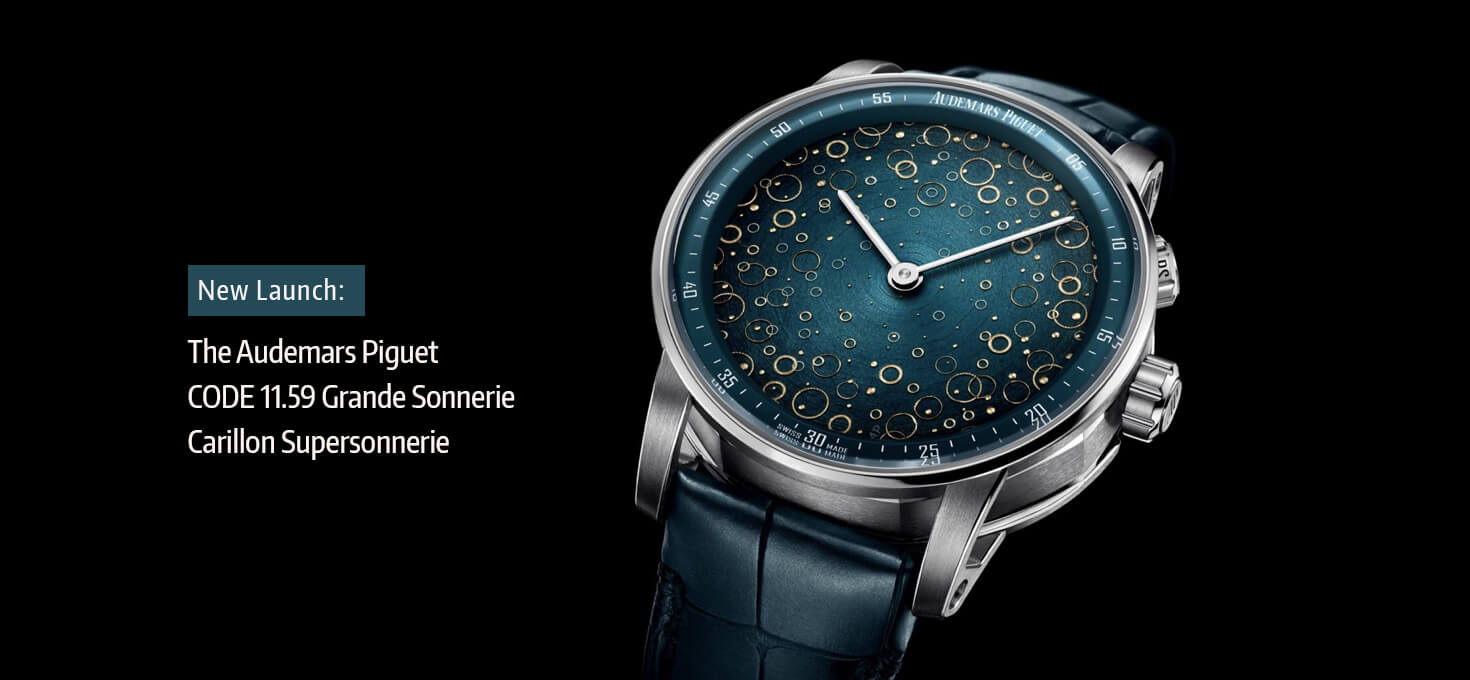Have you heard of minute repeaters? Well, if you haven’t, let’s just begin by saying that they lie somewhere at the very top of high horology complications. Another similar complication is the sonnerie. These complications are not popular because they are modern-day state of the art technology but because watchmakers and enthusiasts like them. Now, Audemars Piguet has introduced yet another marvel of a watch that has a grande sonnerie, the Code 11.59 Grande Sonnerie Carillon Supersonnerie.
The All-New Audemars Piguet CODE 11.59 Grande Sonnerie Carillon Supersonnerie

Chiming watches have something tantalizing about them. They carry a piece of horological history with them that cannot be valued in terms of money. These watches take you all the way back to the 14th century a time when clocks with striking sounds were invented. These devices did not have any dials, so they had to indicate time with sounds. As a matter of fact, Audemars Piguet, since its establishment has been a specialist in chiming clocks.
Amongst all chiming watches, the Grande Sonnerie is the most complicated as well as the rarest. The truth is that this complication never ceased to exist in the Audemars Piguet family. Even before the launch of the Code 11.59, the complication could have been found in the brand’s Jules Audemars line of watches.

The new Audemars Piguet CODE 11.59 Grande Sonnerie Carillon Supersonnerie truly is something. The timepiece looks identical to the other references in the collection. The case stands at 41 mm in width and is built out of 18 carat white gold. The central portion features the iconic AP octagonal structure, the lugs are hollowed as usual and are integrated into the bezel’s frame.

The surfaces of the watch are treated with alternating brushed as well as polished strokes resulting in a rather dynamic pattern. The watch is attached to a hand-stitched blue leather strap along with an 18 carat white gold folding clasp. There are pushers at 2 o clock and 10 o clock and besides that there is nothing indicating the complex nature of this reference.
A Little History Lesson
So, what is a grande sonnerie? Whilst a minute repeater is a complication that hours, minutes, and quarter hours when activated by pushing a button, a grande sonnerie or grand strike in French chimes at hours and quarter hours automatically, that is, unless the user decides to put it on silent mode.
The difference is also in terms of sheer performance. The unlike the minute repeater, the grande sonnerie has to chime four times every hour, 24 hours a day. That is a huge thing in horological terms. Watchmakers need to make sure that each chime is on point. They also need to make sure that the ring tone is accurate and consistent. Not only that but the movement should also be powerful enough to fuel both the complication as well as the time keeping.
The Grande Sonnerie truly is, without a doubt, the epitome of chiming watches.
The Movement
(dial side)

(back side)

The foundation of this horological behemoth is its movement that goes by the name reference 2956. The movement is essentially an upgrade of the movements found in the Jules Audemars watches from 1990s. The entirely hand assembled and decorated engine is composed of 489 components. The movement is capable of delivering about 48 hours of power reserve at a frequency of 3 Hertz.
Inside The Grande Sonnerie
(The original AP grande sonnerie from 1994)

As mentioned in its very name, the watch is fitted with a grande sonnerie. As mentioned earlier, while minute repeaters only chime the time when activated, a grande sonnerie chimes the hours and quarter hours by default, much like a clock tower.
As a grande sonnerie, this timepiece comes with petite sonnerie feature, which means that it chimes only the hours. There is a silent mode, however, that can deactivate all chiming functions. The user can simply select the feature at the 2 o clock marker.
Inside The Minute Repeater

The Code 11.59 Grande Sonnerie includes a minute repeater too. It is activated by a button located at the 10 o clock marker. Another part of the watch’s name indicates “carillonâ€. This translates into the fact that the movement used is facilitated with three gongs and hammers instead of two on a standard minute repeater. As a result, the watch chimes at the quarter-hour with three successive notes, that is, high, medium, and low instead of the usual two.
Inside The Supersonnerie
Finally, this watch is a so-called “Supersonnerieâ€. The objective behind this patented technology, developed by Audemars Piguet in collaboration with the Swiss Federal Institute of Technology Lausanne (EPFL), was to bring the acoustic performance of pocket watches into a wristwatch. The Supersonnerie’s acoustic power, sound quality and harmonic tone are produced by patented gongs and case construction. The gongs are not attached to the mainplate, but to a new device acting as a soundboard.
The Dial

The watch dials for each of the five references in this very limited edition collection are created by none other than Anita Porchet. Anita is arguably the single most popular enamelist in Switzerland at this time. She has mastered all aspects of enameling and that is clearly visible in her work.

She is pretty well known for her paillonné styled enamel work. Paillonné’ gets its name from the tiny and decorative silver or gold paillons {spangles} which are procured one at a time by cutting themfrom a metal foil.

The production of ‘Paillonné’ styled dials is truly a lost art form. A very few enamelists practice this today.





Recent Posts
Recent Comments
Archives